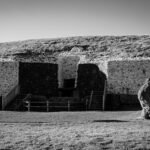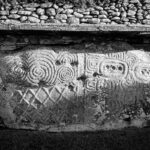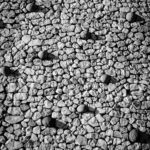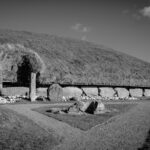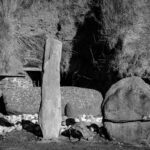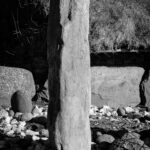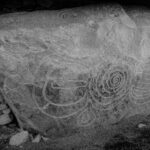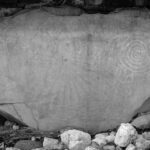The awe-inspiring Brú na Bóinne UNESCO World Heritage Site in County Meath, Ireland.
An ancient monument complex, located in a bend of the River Boyne. It is one of the world’s most important neolithic sites, comprised of at least ninety structures including passage tombs, burial mounds, standing stones and other enclosure types. The site is dominated by the massive passage tombs of Newgrange (Sí an Bhrú), Knowth (Cnogbha) and Dowth (Dubhadh), built during the 32nd century BC. Together these have the largest assemblage of megalithic art in Europe. (Source: Wikipedia)
Newgrange

Newgrange (Irish: Sí an Bhrú) is a neolithic monument, situated on a rise overlooking the River Boyne. It’s an exceptionally grand passage tomb built around 3100 BC, making it older than Stonehenge and the Egyptian pyramids. Newgrange is the main monument in the Brú na Bóinne complex.
Newgrange consists of a large circular mound with an inner stone passageway and cruciform chamber. Burnt and unburnt human bones, and possible grave goods or votive offerings, were found in this chamber. The monument has a striking façade made mostly of angular, flat white quartz and smooth, round cobblestones, and it is ringed by engraved kerbstones. Many of the larger stones of Newgrange are covered in megalithic art. The mound is also ringed by a stone circle. Some of the material that makes up the monument came from as far as the Mournes and Wicklow Mountains. There is no agreement about its purpose, but it is believed it had religious significance. It is precisely aligned so that on each of the few days around the winter solstice the sunlight from rising sun shines through a “roofbox” above the entrance, travels down the passage and floods the deep inner chamber. A spectacle that can still be seen today, with thousands of people entering a lottery to witness the even each year. (Source: Wikipedia)
Knowth

Knowth (Irish: Cnóbha) is a prehistoric tomb overlooking the River Boyne. It is comprised of a large passage tomb surrounded by 17 smaller tombs, built during the Neolithic era around 3200 BC. It contains the largest assemblage of megalithic art in Europe.
The large mound is about 12 metres (40 ft) high and 67 metres (220 ft) in diameter, covering roughly a hectare. It contains two passages placed along an east–west line and is encircled by 127 kerbstones, of which three are missing, and four badly damaged. The passages are independent of each other, leading to separate burial chambers. The eastern passage arrives at a cruciform chamber, not unlike that found at Newgrange, which contains three recesses and basin stones into which the cremated remains of the dead were placed. The right-hand recess is larger and more elaborately decorated with megalithic art than the others, which is typical for Irish passage graves of this type. The western passage ends in an undifferentiated chamber, which is separated from the passage by a sill stone. (Source: Wikipedia)
